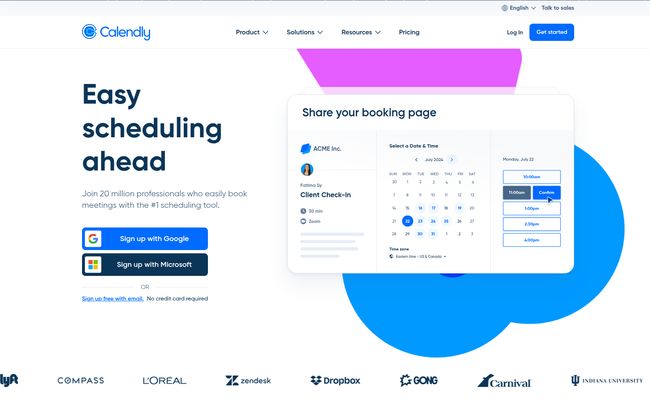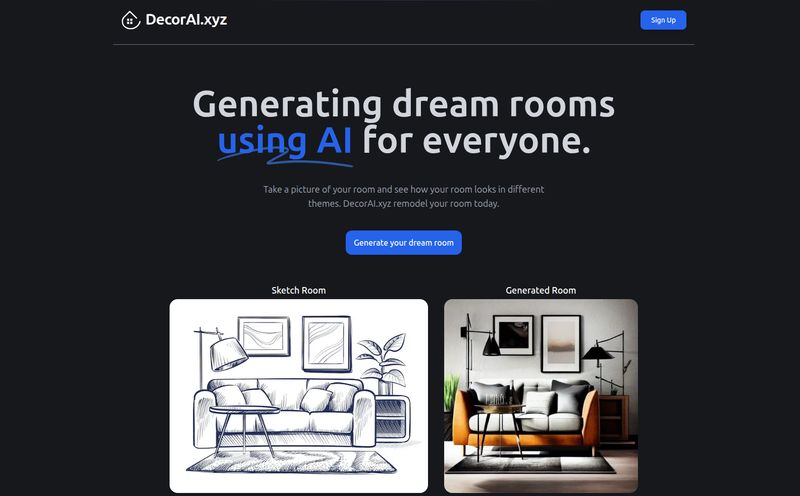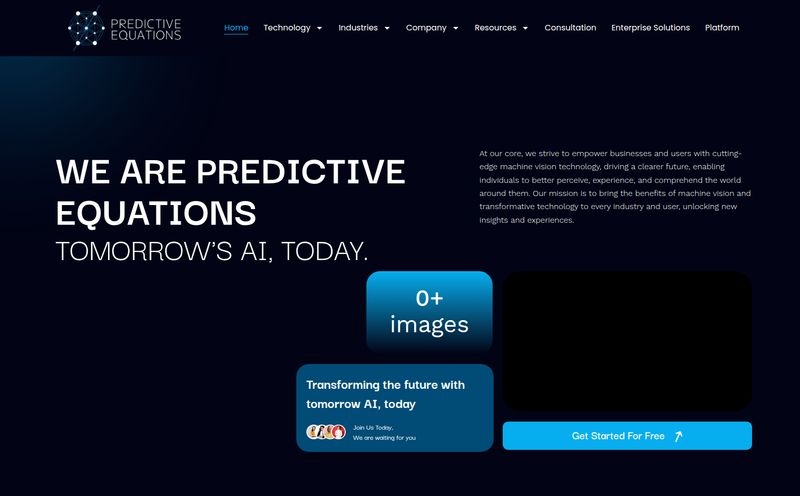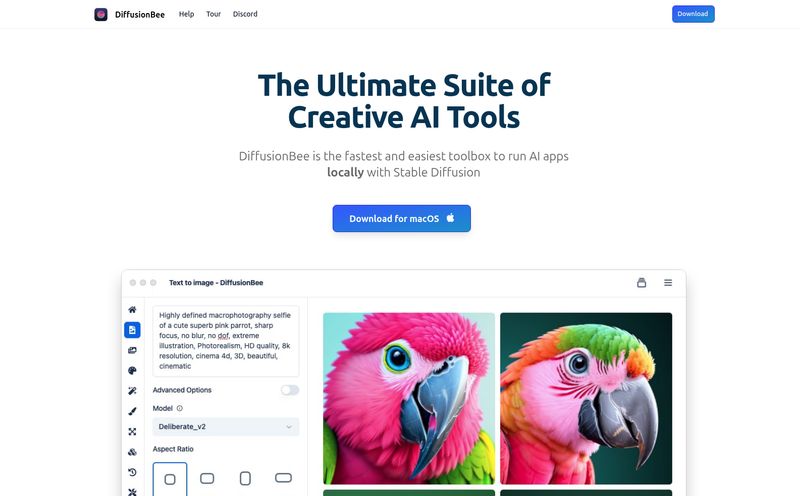I still have nightmares about a listing I had back in 2018. Great bones, fantastic location, but the previous owner’s decor taste was… let’s call it 'aggressively beige'. Every room was a different shade of tan, from sad taupe to depressing ecru. Trying to get potential buyers to see past the sea of bland was like trying to sell a black-and-white movie in an IMAX theater. We spent a fortune on physical staging, and it took weeks.
Fast forward to today, and the game has completely changed. We're in an era where AI isn't just a buzzword for tech bros; it's a practical tool that’s reshaping industries. And real estate is definately feeling the ripple effects. I've been keeping a close eye on a platform that's been making some noise: the Interior Design API. It’s not just another app to add a filter to your photos; it’s a full-blown suite of developer tools designed to automate and elevate property visuals. But is it any good? Let’s get into it.
What Exactly Is This Interior Design API?
Okay, so first things first. The name itself, "Interior Design API," tells you a lot. An API (Application Programming Interface) isn't a standalone program you just download and use. It’s a set of building blocks that developers can use to plug powerful features into their own websites or applications. Think of it like getting a pro-grade espresso machine plumbed directly into your kitchen, instead of just buying a new coffee maker.
This platform provides a whole collection of these AI-powered real estate APIs. The company claims its secret sauce is a proprietary in-house image diffusion model they call ULTRA. A bold name, for sure. But the promise is high-quality, stunningly realistic image transformations that can be integrated directly into a real estate agency's workflow, a property portal, or an architectural firm's software.

Visit Interior Design API
The Full Toolkit: What's Under the Hood?
So what can this thing actually do? It's not just one trick pony. It's more like a Swiss Army knife for digital real estate marketing. The suite of APIs covers pretty much every visual pain point you can imagine.
From Drab to Fab: Interior and Exterior Design APIs
This is the core offering. You can take a photo of an empty room and, with a few prompts, generate multiple design concepts. Modern, minimalist, bohemian, you name it. The same goes for exteriors. Want to show a client what their house would look like with a new coat of paint, different landscaping, or a modern facade? Done. This is huge for developers and flippers trying to sell a vision, not just a property.
The Polishing Tools: Image Enhancement and Day To Dusk
We've all seen those terrible listing photos. You know the ones—dark, grainy, and taken on a flip phone from 2007. The Image Enhancement API is designed to fix that, cleaning up noise and improving lighting. But the Day to Dusk API? That’s my favorite. It transforms a standard daytime shot into a beautiful, warm twilight photo. Everyone in marketing knows that 'golden hour' sells, and this basically creates it on demand. It's pure emotional manipulation, and I love it.
Magic Wands: Sketch to Reality and Item Removal
Now we're getting into the really cool stuff. The Sketch to Reality API is something I wish I had years ago. Imagine a client draws a rough idea for a renovation on a napkin (it happens). This tool can turn that crude sketch into a photorealistic render. Mind-blowing. On the flip side, the Item Removal API is the digital equivalent of a massive cleanup crew. Got a great shot of a living room, but it's full of the current owner's clutter? Poof. Gone. It creates a clean, empty canvas for virtual staging.
The Heavy Hitters: Virtual Staging and Upscaling APIs
Physical staging is expensive, time-consuming, and a logistical headache. Virtual staging has been around for a while, but it's often been clunky or obviously fake. This API aims to change that, populating empty rooms with stylish, realistic furniture. The Upscaling API is a simple but critical problem-solver, taking low-resolution images and making them sharp enough for high-end marketing materials without looking pixelated.
Why Speed Matters in Real Estate (And How This API Delivers)
Here’s something a lot of people outside the industry don't get: the real estate market moves at the speed of light. Getting a listing from “signed” to “live” is a race against time. Every day a property isn't on the market is a day it's costing someone money. This is where the platform’s biggest claim comes into play: renders in less than 30 seconds.
Let that sink in. Less than 30 seconds. While you're making a cup of coffee, you could have generated a half-dozen different design options for a living room. That kind of speed is a total game-changer for productivity. It allows for rapid experimentation and immediate turnarounds for demanding clients. It's like having a design intern who works 24/7, never complains, and is fueled by algorithms instead of caffeine.
Let’s Talk Money: The Pricing Breakdown
Alright, the part everyone is waiting for. How much does this magic cost? The pricing is credit-based, which is common for APIs. You buy a bundle of credits, and each action (like generating an image) uses up a certain number of them. You’ll have to monitor your usage, but it’s transparent.
| Plan | Price per Month | Credits Included |
|---|---|---|
| Standard | $450 | 4,000 |
| Pro | $750 | 8,000 |
| Ultimate | $1,350 | 16,000 |
| Enterprise | Contact for Quote | Unlimited |
The pricing is clearly aimed at businesses, not casual hobbyists. But when you compare it to the cost of traditional photography, staging, and design services, the value proposition becomes pretty clear for high-volume agencies.
The Good, The Bad, and The AI-Generated
No tool is perfect. In my experience, it’s always a mix of pros and cons. Here's my honest take.
The Upsides (My Favorite Parts)
The speed is the number one thing for me. Getting multiple, high-quality renders done simultaneously is just incredible. The quality, thanks to that ULTRA model they keep talking about, genuinely looks good—much better than the early-gen AI stuff. And the cost, when spread across dozens or hundreds of listings, is much more predictable and often lower than hiring freelancers for every little job. Plus, 24/7 support is a big plus when you're on a tight deadline.
A Few Things to Keep in Mind
The credit-based pricing can be a double-edged sword. If you're not careful, you can burn through them quickly. It requires some management. Also, let's be realistic: AI is not infallible. You will occasionally get a weird render—a chair with three legs, a picture frame that melts into the wall. It’s the nature of the beast. You're also dependent on their API being up and running. If their servers go down, your fancy integrated tool goes down with it.
Who Is This Really For?
So, who should be calling their developer right now? In my opinion, this is a perfect fit for a few key groups. Large real estate brokerages that want to offer a unique, high-tech service to their agents and clients. Property development firms that need to create marketing materials for projects that don't exist yet. And I could even see large furniture retailers using it to create an integrated "see this in your room" feature on their websites. It’s for businesses that operate at a scale where efficiency, speed, and a consistent brand image are top priorities.
Frequently Asked Questions about the Interior Design API
- How does the credit system work?
- Think of credits like tokens at an arcade. Each function, like generating a virtual staging image or removing an item, costs a certain number of credits. You buy a monthly plan that gives you a bucket of credits to use as you see fit.
- What is the “ULTRA” image model?
- ULTRA is the company's proprietary AI model. It's the engine that powers all the image generation. They've trained it specifically on real estate and design data to produce higher quality, more realistic, and more context-aware outputs than general-purpose AI image models.
- Can I use this if I'm not a developer?
- Not directly. This is an API, which means it’s meant to be integrated into other software by a developer. However, a brokerage or company could build a very user-friendly tool for its agents using this API, so the end-user wouldn't need any technical skills.
- Is the AI output good enough to replace a human designer?
- Some purists will scream no, but the answer is nuanced. I see it as a powerful assistant, not a replacement. It's fantastic for generating initial ideas, creating marketing visuals, and handling repetitive tasks. But a human designer's expertise in space planning, material sourcing, and client psychology is still invaluable for a full project.
- How fast are the render generations really?
- Based on their claims and early reports, the sub-30-second figure is for a standard render. More complex tasks might vary, but the performance is designed for high-speed, high-volume commercial use, which is a major selling point.
Final Thoughts: Is This the Future of Property Tech?
So, is the Interior Design API the silver bullet that will solve all our real estate marketing woes? Of course not. But it’s a seriously powerful weapon to have in your arsenal. It’s a tool that, in the right hands, can save an incredible amount of time and money, all while producing a higher quality visual product for listings.
It represents a shift from manual, labor-intensive processes to automated, AI-driven efficiency. It won't replace the need for a good agent or a talented designer, but it will empower them to do their jobs better and faster. For any real estate business looking to gain a competitive edge in an increasingly visual market, ignoring tools like this isn't an option anymore. The future of property visuals isn't just coming; for many, it's already here.
Reference and Sources
- The Importance of Professional Real Estate Photos (Zillow)
- How AI Is Transforming The Real Estate Industry (Forbes)
- Interior Design API Official Pricing/Meeting Page



